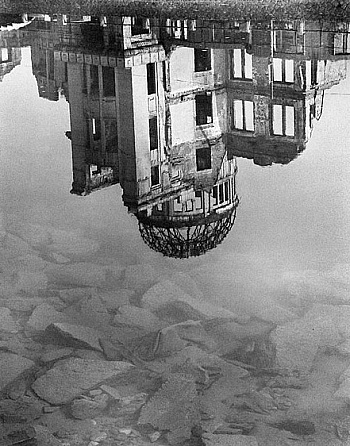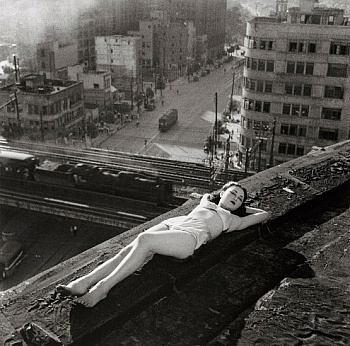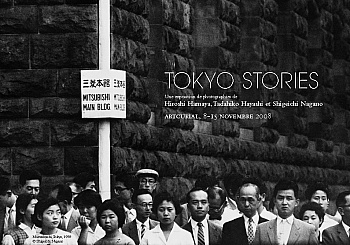
Tadahiko Hayashi
#Photographe
- Exposition
Metamorphosis of Japan after the War (1945-1964)
 In the years following the Second World War in Japan, photography played an important role in the development of a new national identity. From the shock of the atomic bomb to the country's re-emergence at the 1964 Olympics in Tokyo, important photographers documented the birth of a new Japanese nation. This exhibition includes 123 photographs, as well as books, magazines and exhibition catalogues featuring works from 11 leading representatives of Japanese photography of these years.
In the mid-1950s a group of photographers came to the fore who started to move away from the sombre photo journalism that depicted the misery of the years immediately following the war. Affiliated with the Vivo photography agency, these photographers examined the consequences of the massive modernisation process that gripped the co...
In the years following the Second World War in Japan, photography played an important role in the development of a new national identity. From the shock of the atomic bomb to the country's re-emergence at the 1964 Olympics in Tokyo, important photographers documented the birth of a new Japanese nation. This exhibition includes 123 photographs, as well as books, magazines and exhibition catalogues featuring works from 11 leading representatives of Japanese photography of these years.
In the mid-1950s a group of photographers came to the fore who started to move away from the sombre photo journalism that depicted the misery of the years immediately following the war. Affiliated with the Vivo photography agency, these photographers examined the consequences of the massive modernisation process that gripped the co... - Exposition
Tokyo Stories opening at Kulturhuset, Stockholm
 Studio Equis presents Tokyo Stories, a group exhibition revealing the multiple faces of Tokyo from the 1930s to the present day. A limited edition portfolio of 9 Digigraphie prints by Epson will be available at Kulturhuset during the exhibition.
With over 100 rare prints, many of which have previously never been seen outside of Japan, Tokyo Stories shows the dramatic evolution of the Japanese capital through the work of three of Japan’s leading documentary photographers: Hiroshi Hamaya, Tadahiko Hayashi and Shigeichi Nagano.
The exhibition was first presented at Artcurial in Paris in November 2008 as part of the official programme of Paris Photo....
Studio Equis presents Tokyo Stories, a group exhibition revealing the multiple faces of Tokyo from the 1930s to the present day. A limited edition portfolio of 9 Digigraphie prints by Epson will be available at Kulturhuset during the exhibition.
With over 100 rare prints, many of which have previously never been seen outside of Japan, Tokyo Stories shows the dramatic evolution of the Japanese capital through the work of three of Japan’s leading documentary photographers: Hiroshi Hamaya, Tadahiko Hayashi and Shigeichi Nagano.
The exhibition was first presented at Artcurial in Paris in November 2008 as part of the official programme of Paris Photo.... - Exposition
Tokyo Stories - Hiroshi Hamaya, Tadahiko Hayashi & Shigeichi Nagano
 Focusing on street life, its spontaneity and drama, three of Japan’s leading photographers document a city in change. With close to 100 rare prints, many of which have previously never been seen outside of Japan, Tokyo Stories reveals the changing faces of Tokyo from the 1930s until the present day.
Tokyo is a city of contrasts, a kaleidoscope of images, where the futuristic present thrives alongside the traditional past. The exhibition reveals the city through its people: student protests, political intrigues, the birth of ‘salary men’ and their endless workdays, geishas, prostitutes, street orphans, writers, artists, designers and fashionistas, all of these characters collide to create this city of layers and contrasts.
As a native of Tokyo, the city naturally became Hiroshi Hamaya&r...
Focusing on street life, its spontaneity and drama, three of Japan’s leading photographers document a city in change. With close to 100 rare prints, many of which have previously never been seen outside of Japan, Tokyo Stories reveals the changing faces of Tokyo from the 1930s until the present day.
Tokyo is a city of contrasts, a kaleidoscope of images, where the futuristic present thrives alongside the traditional past. The exhibition reveals the city through its people: student protests, political intrigues, the birth of ‘salary men’ and their endless workdays, geishas, prostitutes, street orphans, writers, artists, designers and fashionistas, all of these characters collide to create this city of layers and contrasts.
As a native of Tokyo, the city naturally became Hiroshi Hamaya&r... - Exposition
Japan: a Self-Portrait, Photographs 1945-1964
 Concept
On August 15th, 1945 the Pacific War came to an end and with it fourteen years of bombings, of deprivation and of great sacrifice for the Japanese people. With the collapse of Japanese militaristic rule and the arrival of the US occupation forces, the nation suddenly found itself thrust into a new and uncertain era. The myth of the Emperor's divinity, which was born during the Meiji era, was replaced with the American attempt at their homegrown brand of democratisation.
The belief in the Emperor and his government, which had accompanied Japan's development for several decades, was shattered. At the same time, despite the surrounding physical destruction, a feeling of intense relief swept across the country accompanied by a thirst for freedom and creative expression. The Japanese people craved discovery: the...
Concept
On August 15th, 1945 the Pacific War came to an end and with it fourteen years of bombings, of deprivation and of great sacrifice for the Japanese people. With the collapse of Japanese militaristic rule and the arrival of the US occupation forces, the nation suddenly found itself thrust into a new and uncertain era. The myth of the Emperor's divinity, which was born during the Meiji era, was replaced with the American attempt at their homegrown brand of democratisation.
The belief in the Emperor and his government, which had accompanied Japan's development for several decades, was shattered. At the same time, despite the surrounding physical destruction, a feeling of intense relief swept across the country accompanied by a thirst for freedom and creative expression. The Japanese people craved discovery: the... - Exposition
Tokyo Stories photographies de Hiroshi Hamaya, Tadahiko Hayashi et Shigeichi Nagano
 Studio Equis présente, avec le soutien d’Epson, une exposition exceptionnelle, « Tokyo Stories », chez Artcurial du 8 au 15 novembre 2008. Près de 100 tirages rares, inédits pour la plupart hors du Japon, révèlent les personnalités multiples de Tokyo, des années 1930 à la fin du XXe siècle, à travers les oeuvres de trois photographes : Hiroshi Hamaya, Tadahiko Hayashi et Shigeichi Nagano.
Originaire de Tokyo, Hamaya (né en 1915) fait de sa ville son premier sujet photographique. Ses clichés des années 1930 révèlent une ville mystérieuse et exotique, radicalement différente de la mégalopole qu’on connait aujourd’hui. Hayashi (né en 1918), quand à lui, ...
Studio Equis présente, avec le soutien d’Epson, une exposition exceptionnelle, « Tokyo Stories », chez Artcurial du 8 au 15 novembre 2008. Près de 100 tirages rares, inédits pour la plupart hors du Japon, révèlent les personnalités multiples de Tokyo, des années 1930 à la fin du XXe siècle, à travers les oeuvres de trois photographes : Hiroshi Hamaya, Tadahiko Hayashi et Shigeichi Nagano.
Originaire de Tokyo, Hamaya (né en 1915) fait de sa ville son premier sujet photographique. Ses clichés des années 1930 révèlent une ville mystérieuse et exotique, radicalement différente de la mégalopole qu’on connait aujourd’hui. Hayashi (né en 1918), quand à lui, ...
Modifier l'image
 In the years following the Second World War in Japan, photography played an important role in the development of a new national identity. From the shock of the atomic bomb to the country's re-emergence at the 1964 Olympics in Tokyo, important photographers documented the birth of a new Japanese nation. This exhibition includes 123 photographs, as well as books, magazines and exhibition catalogues featuring works from 11 leading representatives of Japanese photography of these years.
In the mid-1950s a group of photographers came to the fore who started to move away from the sombre photo journalism that depicted the misery of the years immediately following the war. Affiliated with the Vivo photography agency, these photographers examined the consequences of the massive modernisation process that gripped the co...
In the years following the Second World War in Japan, photography played an important role in the development of a new national identity. From the shock of the atomic bomb to the country's re-emergence at the 1964 Olympics in Tokyo, important photographers documented the birth of a new Japanese nation. This exhibition includes 123 photographs, as well as books, magazines and exhibition catalogues featuring works from 11 leading representatives of Japanese photography of these years.
In the mid-1950s a group of photographers came to the fore who started to move away from the sombre photo journalism that depicted the misery of the years immediately following the war. Affiliated with the Vivo photography agency, these photographers examined the consequences of the massive modernisation process that gripped the co... Studio Equis presents Tokyo Stories, a group exhibition revealing the multiple faces of Tokyo from the 1930s to the present day. A limited edition portfolio of 9 Digigraphie prints by Epson will be available at Kulturhuset during the exhibition.
With over 100 rare prints, many of which have previously never been seen outside of Japan, Tokyo Stories shows the dramatic evolution of the Japanese capital through the work of three of Japan’s leading documentary photographers: Hiroshi Hamaya, Tadahiko Hayashi and Shigeichi Nagano.
The exhibition was first presented at Artcurial in Paris in November 2008 as part of the official programme of Paris Photo....
Studio Equis presents Tokyo Stories, a group exhibition revealing the multiple faces of Tokyo from the 1930s to the present day. A limited edition portfolio of 9 Digigraphie prints by Epson will be available at Kulturhuset during the exhibition.
With over 100 rare prints, many of which have previously never been seen outside of Japan, Tokyo Stories shows the dramatic evolution of the Japanese capital through the work of three of Japan’s leading documentary photographers: Hiroshi Hamaya, Tadahiko Hayashi and Shigeichi Nagano.
The exhibition was first presented at Artcurial in Paris in November 2008 as part of the official programme of Paris Photo.... Focusing on street life, its spontaneity and drama, three of Japan’s leading photographers document a city in change. With close to 100 rare prints, many of which have previously never been seen outside of Japan, Tokyo Stories reveals the changing faces of Tokyo from the 1930s until the present day.
Tokyo is a city of contrasts, a kaleidoscope of images, where the futuristic present thrives alongside the traditional past. The exhibition reveals the city through its people: student protests, political intrigues, the birth of ‘salary men’ and their endless workdays, geishas, prostitutes, street orphans, writers, artists, designers and fashionistas, all of these characters collide to create this city of layers and contrasts.
As a native of Tokyo, the city naturally became Hiroshi Hamaya&r...
Focusing on street life, its spontaneity and drama, three of Japan’s leading photographers document a city in change. With close to 100 rare prints, many of which have previously never been seen outside of Japan, Tokyo Stories reveals the changing faces of Tokyo from the 1930s until the present day.
Tokyo is a city of contrasts, a kaleidoscope of images, where the futuristic present thrives alongside the traditional past. The exhibition reveals the city through its people: student protests, political intrigues, the birth of ‘salary men’ and their endless workdays, geishas, prostitutes, street orphans, writers, artists, designers and fashionistas, all of these characters collide to create this city of layers and contrasts.
As a native of Tokyo, the city naturally became Hiroshi Hamaya&r... Concept
On August 15th, 1945 the Pacific War came to an end and with it fourteen years of bombings, of deprivation and of great sacrifice for the Japanese people. With the collapse of Japanese militaristic rule and the arrival of the US occupation forces, the nation suddenly found itself thrust into a new and uncertain era. The myth of the Emperor's divinity, which was born during the Meiji era, was replaced with the American attempt at their homegrown brand of democratisation.
The belief in the Emperor and his government, which had accompanied Japan's development for several decades, was shattered. At the same time, despite the surrounding physical destruction, a feeling of intense relief swept across the country accompanied by a thirst for freedom and creative expression. The Japanese people craved discovery: the...
Concept
On August 15th, 1945 the Pacific War came to an end and with it fourteen years of bombings, of deprivation and of great sacrifice for the Japanese people. With the collapse of Japanese militaristic rule and the arrival of the US occupation forces, the nation suddenly found itself thrust into a new and uncertain era. The myth of the Emperor's divinity, which was born during the Meiji era, was replaced with the American attempt at their homegrown brand of democratisation.
The belief in the Emperor and his government, which had accompanied Japan's development for several decades, was shattered. At the same time, despite the surrounding physical destruction, a feeling of intense relief swept across the country accompanied by a thirst for freedom and creative expression. The Japanese people craved discovery: the... Studio Equis présente, avec le soutien d’Epson, une exposition exceptionnelle, « Tokyo Stories », chez Artcurial du 8 au 15 novembre 2008. Près de 100 tirages rares, inédits pour la plupart hors du Japon, révèlent les personnalités multiples de Tokyo, des années 1930 à la fin du XXe siècle, à travers les oeuvres de trois photographes : Hiroshi Hamaya, Tadahiko Hayashi et Shigeichi Nagano.
Originaire de Tokyo, Hamaya (né en 1915) fait de sa ville son premier sujet photographique. Ses clichés des années 1930 révèlent une ville mystérieuse et exotique, radicalement différente de la mégalopole qu’on connait aujourd’hui. Hayashi (né en 1918), quand à lui, ...
Studio Equis présente, avec le soutien d’Epson, une exposition exceptionnelle, « Tokyo Stories », chez Artcurial du 8 au 15 novembre 2008. Près de 100 tirages rares, inédits pour la plupart hors du Japon, révèlent les personnalités multiples de Tokyo, des années 1930 à la fin du XXe siècle, à travers les oeuvres de trois photographes : Hiroshi Hamaya, Tadahiko Hayashi et Shigeichi Nagano.
Originaire de Tokyo, Hamaya (né en 1915) fait de sa ville son premier sujet photographique. Ses clichés des années 1930 révèlent une ville mystérieuse et exotique, radicalement différente de la mégalopole qu’on connait aujourd’hui. Hayashi (né en 1918), quand à lui, ...